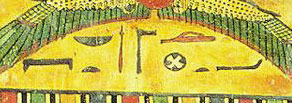|
|
» LIBER SCRIPTUM «

Frater D.M.T. et.al
The Stéle of Revealing
“Get the stele of revealing itself; set it in thy secret temple
— and that temple is already aright disposed —
& it shall be your Kiblah for ever.”
[Liber CCXX, Chapter III, Verse 10.]

TABLE OF CONTENTS
[ « back to TOC ]

THE STELE OF REVEALING
The Stele of Ankh-ef-en-Khonsu i (also known as the Stele of Revealing) is a painted, wooden offering stele, discovered in 1858 at the mortuary temple of Hatshepsut at Dayr al-Bahri by François Auguste Ferdinand Mariette. It was originally made for the Montu-priest Ankh-ef-en-Khonsu i, and was discovered near his coffin ensemble of two sarcophagi and two anthropomorphic inner coffins. It dates to circa 680/70 BCE, the period of the late Dynasty 25/early Dynasty 26. Originally located in the former Bulaq Museum under inventory number 666, the stele was moved around 1902 to the newly opened Egyptian Museum of Cairo (inventory number A 9422; Temporary Register Number 25/12/24/11), where it remains today.
The stele is made of wood and covered with a plaster gesso, which has been painted. It measures 51.5 centimeters high and 31 centimeters wide. On the front Ankh-ef-en-Khonsu is as a priest of Montu can be seen; he is presenting offerings to the falcon-headed god Re-Harakhty ("Re-Horus of the Two Horizons"), a syncretic form of the gods Ra and Horus, who is seated on a throne. The symbol of the west, the place of the Dead, is seen behind Re-Harakhty. Above the figures is a depiction of Nuit, the sky goddess who stretches from horizon to horizon. Directly beneath her is the Winged Solar Disk, Horus of Behdet.
The stele is also known as the "Stele of Revealing" and is a central element of the religious philosophy Thelema founded by Aleister Crowley.
The stele is a fairly typical example of a late Third Intermediate Period Theban offering stele dating to the late Dynasty 25/early Dynasty 26. It was discovered in 1854 as part of a large burial of priests of Montu at Dayr al-Bahri, and included the coffin of the dedicant, Ankh-ef-en-Khonsu.
{source: Wikipedia}
The Stele of Revealing
The image of The Stele of Revealing above is taken from the first edition of the Equinox of the Gods and is not a photo of the original stele.
(It has a typo in hieroglyphs.) The original stele can be seen below. ----- [Ed.]
|
|
|
Stele Of Revealing front
original - Cairo Museum |
Stele Of Revealing back
original - Cairo Museum |
Rose and Aleister Crowley |
|
|
|
| Heiroglyphs transcript by Crowley |
French transcript by Crowley |
Liber AL vel Legis (page 1) |
[ » LIBER XXXI - The Holograph Manuscript of Liber AL vel Legis « ]
The Stèle of Revealing (also called Stèle 666) was discovered by Aleister Crowley and his wife Rose in the Boulaq Museum in Cairo, Egypt on March 18, 1904. For the previous two days, she had been receiving the message, “They are waiting for you” and claimed that it was from Horus. When Aleister took her to the museum to point out the speaker to him, she finally settled on this small, unassuming funerary stele. What struck Crowley was that it did indeed show Horus, and attached to the top was the exhibit number: 666, the number that he strongly identified himself with. The discovery of the Stele of Revealing was an important step in the events leading to the writing of The Book of the Law.
The Stele of Revealing was created by an actual Egyptian priest of the god Mentu, Ankh-af-na-khonsu (lit. He Lives in Khonsu), who lived in Thebes in the 26th dynasty (apx. 725 PEV). It is a funerary tablet created to commemorate his death. It is wooden, covered with stucco and painted on both sides. It is rounded at the top and measures 51.5 by 31 centimeters.
On April 8 1904, the voice of the Goddess Nuith spoke through the intermediary of the intelligence known as Aiwass, to deliver the first chapter of The Holiest Book of Thelema, The Book of the Law, Liber AL vel Legis. A month earlier Rose Crowley, Ouarda the Seer, had told her husband "they are waiting for you" and later directed his attention to Stélé 666 in Cairo's Boulak museum.
Her instructions were that Crowley should enter the room "exactly at noon on April 8, 9 & 10, and write down what I had heard, rising exactly at one o'clock.
"March 23rd to April 7th. I made inquiries about the stele and had the inscriptions translated into French by the assistant curator at Boulak. I made poetic paraphrases of them. Ouarda now told me to enter the room, where all this work had been done, exactly at noon on April 8th, 9th and 10th, and write down what I heard, rising exactly at one o'clock. This is did. In these three hours were written the three chapters of The Book of the Law.
The above statement is as succinct as I can make it. By April 8th, I had been convinced of the reality of the communication and obeyed my wife's arbitrary instructions with a certain confidence. I retained my sceptical attitude none the less.
THE CLAIM OF THE BOOK OF THE LAW IN RESPECT OF RELIGION.
The importance of religion to humanity is paramount. The reason is that all men perceive more of less the "First Noble Truth" --- that everything is sorrow; and religion claims to console them by an authoritative denial of this truth or by promising compensations in other states of existence. This claim implies the possibility of knowledge derived from sources other than the unaided investigation of nature through the senses and the intellect. It postulates, therefore, the existence of one or more praeter-human intelligences, able and willing to communicate, through the medium of certain chosen man, to mankind a truth or truths which could not otherwise be known. Religion is justified in demanding faith, since the evidence of the senses and the mind cannot confirm its statements. The evidence from prophecy and miracle is valid only in so far as it goes to the credit of the man through whom the communication is made. It establishes that he is in possession of knowledge and power different, not only in degree but in kind, from those enjoyed by the rest of man kind." (Aleister Crowley)
[ from THE CONFESSIONS OF ALEISTER CROWLEY - An Autohagiography Part III. {p. 395})] ---- [Ed.]
|
[ « back to TOC ]

Finding the Stèle of Revealing
“A glass case stood in the distance, too far off for its contents to be recognized. But [Rose Kelly] recognised it! ‘There,’ she cried, ‘There he is!’”
“Fra. P. advanced to the case. There was the image of Horus in the form of Ra Hoor Khuit painted upon a wooden stele of the 26th dynasty—and the exhibit bore the number 666!”
“In the museum at Cairo, No. 666 is the stele of the Priest Ankh-f-n- khonsu. Horus has a red Disk and green Uraeus.
His face is green, his skin indigo.
His necklace, anklets, and bracelets are gold.
His nemyss nearly black from blue.
His tunic is the Leopard’s skin, and his apron green and gold.
Green is the wand of double Power; his r.h. is empty.
His throne is indigo the gnomon, red the square.
The light is gamboge.
Above his are the Winged Globe and the bent figure of the heavenly Isis, her hands and feet touching earth.”
[ « back to TOC ]

Aleister Crowley's Stèle Poem
According to Crowley, the stela depicts the three chief deities of Thelema: Nuit (Egyptian Nut), Hadit (Egyptian Behdety), and Ra-Hoor-Khuit (Egyptian Re-Harakhty ["Re-Horus of the Two Horizons"]).
 |
 |
| |
|
A PARAPHRASE OF THE INSCRIPTIONS UPON
THE OBVERSE OF THE STELE OF REVELLING
Above, the gemmèd azure is
The naked splendour of Nuit;
She bends in ecstasy to kiss
The secret ardours of Hadit.
The wingèd globe, the starry blue
Are mine, o Ankh-f-n-Khonsu.
I am the Lord of Thebes, and I
The inspired forth-speaker of Mentu;
For me unveils the veiled sky,
The self-slain Ankh-f-n-Khonsu
Whose words are truth. I invoke, I greet
Thy presence, o Ra-Hoor-Khuit!
Unity uttermost showed!
I adore the might of Thy breath,
Supreme and terrible God,
Who makest the gods and death
To tremble before Thee: —
I, I adore thee!
Appear on the throne of Ra!
Open the ways of the Khu!
Lighten the ways of the Ka!
The ways of the Khabs run through
To stir me or still me!
Aum! let it kill me!
The Light is mine; its rays consume
Me: I have made a secret door
Into the House of Ra and Tum,
Of Khephra, and of Ahathoor.
I am thy Theban, o Mentu,
The prophet Ankh-f-n-Khonsu!
By Bes-na-Maut my breast I beat:
By wise Ta-nech I weave my spell.
Show thy star-splendour, O Nuit!
Bid me within thine House to dwell,
O winged snake of light, Hadith!
Abide with me, Ra-Hoor-Khuit!
|
A PARAPHRASE OF THE HIEROGLYPHS OF THE
11 LINES UPON THE REVERSE OF THE STELE
Saith of Mentu the truth-telling brother
Who was master of Thebes from his birth:
O heart of me, heart of my mother!
O heart which I had upon earth!
Stand not thou up against me as a witness!
Oppose me not, judge, in my quest!
Accuse me not now of unfitness
Before the Great God, the dread Lord of the West!
For I fastened the one to the other
With a spell for their mystical girth,
The earth and the wonderful West,
When I flourished, o earth, on thy breast!
The dead man Ankh-f-n-Khonsu
Saith with his voice of truth and calm:
O thou that hast a single arm!
O thou that glitterest in the moon!
I weave thee in the spinning charm;
I lure thee with the billowy tune.
The dead man Ankh-f-n-Khonsu
Hath parted from the darkling crowds,
Hath joined the dwellers of the light,
Opening Duant, the star-abodes,
Their keys receiving.
The dead man Ankh-f-n-Khonsu
Hath made his passage into night,
His pleasure on the earth to do
Among the living.
|
(Aleister Crowley’s poetic rendition of the Stèle text, from The Temple of Solomon the King in Equinox I. viii)
[ Parts of this poetic version also appear in Liber NU, Liber Resh vel Helios, in the text of Liber AL vel Legis and many more. ]
[ « back to TOC ]

The stele is painted on both faces with Egyptian texts, some of which are Chapter 91 of the Egyptian Book of the Dead, while the back of the stele records eleven lines of text from Chapters 30 and 2.
The text reads as follows.:
Obverse

[A1] Beneath the Winged Solar Disk: (He of) Behdet, the Great God, Lord of Heaven

[A2–A3] Above Re-Harakhty: Re-Harakhty ("Re-Horus of the Two Horizons"), Chief of the Gods
[A4–A8] Above Ankh-ef-en-Khonsu: The Osiris, God's Servant of Montu, Lord of Waset, Opener of the Door-leaves of Heaven in the Most Select of Places (i.e., Karnak), Ankh-ef-en-Khonsu, <True of> Voice

[A9] Beneath the offering table: (1000s of) Bread and beer, cattle and fowl

[B1–B5] Main text: [B1] Words spoken by the Osiris (i.e., the deceased), God's Servant of Montu, Lord of Waset, Opener of the Door-leaves of Heaven in the Most Select of Places (i.e., Karnak), Ankh-ef-en-Khonsu, [B2] True of Voice: "O Exalted-one! may he be praised, Great of Manifestations, the great Ba whom [B3] the gods fear, and who appears on his great throne, make the path of the Ba, the Akh, and the Shadow, for I am equipped so that (I) might shine therein [B4] (as) an equipped-one. Make for me the path to the place in which Re, Atum, Khepri, and Hathor are therein." The Osiris, God's Servant of Montu, Lord of Waset, [B5] Ankh-ef-en-Khonsu, <True of> Voice, son of the like titled Ba-sa-en-Mut, borne of the Chantress of Amun-Re, Lady of the House, Ta-nesh<et>.
Reverse

[C1] Words spoken by the Osiris (i.e., the deceased), God's Servant of Montu, Lord of Waset, Ankh-ef-en- [C2] Khonsu, True of Voice: "(O) my heart of my mother [2 times], (O) my heart while I existed [C3] upon earth, do not stand against me as a witness, do not oppose me in [C4] in the tribunal, do not be hostile against me in the presence of the Great God, Lord of the West. [C5] Although I have united (myself) to the land to the great western side of Heaven, may I flourish upon earth!" [C6] Words spoken by the Osiris, the Stolist of Waset, Ankh-ef-en-Khonsu, True of Voice: O (you who are) Unique [C7] of Arm, who shines like the moon, the Osiris, Ankh-ef- [C8] en-Khonsu, goes forth from your multitudes, [C9] (O) deliverer of those who are within the sun-light, open for him [C10] the Netherworld, indeed, the Osiris, Ankh-ef-en-Khonsu who goes forth in [C11] day in order to do everything all that pleased him upon earth among the living-ones."
[ « back to TOC ]

Translations
Crowley states that he dined with the Egyptologist Émile Charles Albert Brugsch bey, Curator of the Bulaq Museum to discuss the stele in his charge and to arrange for a facsimile to be made. According to Crowley, Brugsch's French assistant curator translated the hieroglyphic text on the stele. In 1912 a second translation was later made for Crowley by Alan Gardiner and Battiscombe Gunn.
The Gardiner Translation
A translation of the Stèle text, by Dr. Alan Gardiner and Battiscombe Gunn.
STELE OF ANKH-F-NA-KHONSU.
OBVERSE.
Topmost Register (under Winged Disk).
Behdet (? Hadit ?), the Great God, the Lord of Heaven.
Middle Register.
Two vertical lines to left: –
Ra-Harakhti, Master of the Gods.
Five vertical lines to right: —
Osiris, the Priest of Montu, Lord of Thebes, Opener of the doors of Nut in Karnak, Ankh-f-na-Khonsu, the Justified.
Below Altar: –
Oxen, Geese, Wine, (?) Bread.
Behind the god is the hieroglyph of Amenti.
Lowest Register.
(1) Saith Osiris, the Priest of Montu, Lord of Thebes, the Opener of the Doors of Nut in Karnak, Ankh-f-na-Khonsu, (2) the Justified: — “Hail, Thou whose praise is high (the highly praised), thou great- willed, O Soul (ba) very awful (lit. mighty of awe) that giveth the terror of him (3) among the Gods, shining in glory upon his great throne, making ways for the Soul (ba), for the Spirit (yekh) and for the Shadow (khabt). I am prepared, and I shine forth as one that is prepared. (4) I have made way to the place in which are Ra, Tom, Khepri and Hathor.”
Osiris, the Priest of Montu, Lord of Thebes, (5) Ankh-f-na-Khonsu, the Justified; son of MNBSNMT (The father's name. The method of spelling shows that he was a foreigner. There is no clue to the vocalisation); born of the Sistrum-bearer of Amon, the Lady Atne-sher.
REVERSE
Eleven lines of writing.
(1) Saith Osiris, the Priest of Montu, Lord of Thebes, Ankh-f- (2)na-Khonsu, the Justified:—“My heart from my mother, my heart from my mother, my heart of my existence (3) upon earth, stand not forth against me as a witness, drive me not back (4) among the Sovereign Judges, neither incline against me in the presence of the Great God, the Lord of the West. (5) Now that I am united with Earth in the Great West, and endure no longer upon Earth.”
(6) Saith Osiris, he who is in Thebes, Ankh-f-na-Khonsu, the Justified:—&“O Only- (7)One, shining like (or in) the Moon; Osiris Ankh-f- (8)na-Khonsu has come forth upon high among these thy multitudes. (9) He that gathereth together those that are in the Light, the Underworld (duat) is [also] (10) opened to him; lo, Osiris Ankh-f-na-Khonsu, cometh forth by (11) day to do all that he wisheth upon earth among the living.”
[ « back to TOC ]

The Liber Portal Hieroglyphics
If you’ve wondered what the hieroglyphics at the bottom of the portal graphic used for all of Crowley’s libers are, then you can find out by examining the Stèle. From Gardiner’s translation these are the sections “Behdet (? Hadit ?), the Great God, the Lord of Heaven” and “Oxen, Geese, Wine, (?) Bread”. Essentially, the language suggests “Meat”, “Drink” and “Hadit”.

Compare the Stèle to the Liber Portal


“And, for as much as meat and drink are transmuted in us daily into spiritual substance, I believe in the Miracle of the Mass.” — Liber XV
In some images of the Stèle, there is what appears to be damage at the top of the front, probably from a label, which has been repaired in other images:

(damage on the original Stéle)
[ « back to TOC ]
To be continued...
Proof read and edited by Frater D.M.T.
Contributed to Bahlasti Ompehda O.T.O. (Hungary, Anno Viii)
[ » Primary Source: The Stele of Revealing « ]

BACK TO LIBRARY

|
|







